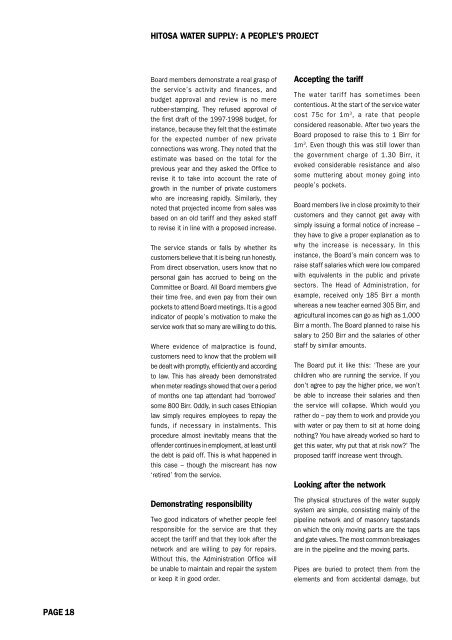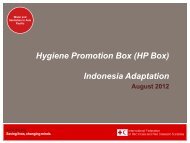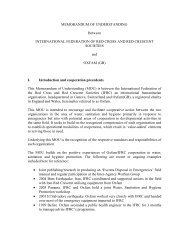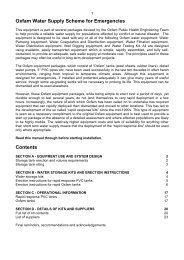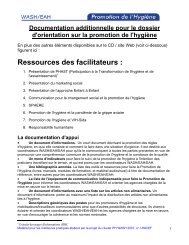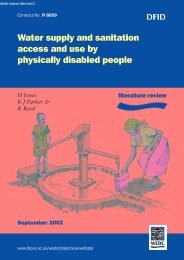Hitosa water supply: a people's project - watsanmissionassistant
Hitosa water supply: a people's project - watsanmissionassistant
Hitosa water supply: a people's project - watsanmissionassistant
Create successful ePaper yourself
Turn your PDF publications into a flip-book with our unique Google optimized e-Paper software.
HITOSA WATER SUPPLY: A PEOPLE’S PROJECTBoard members demonstrate a real grasp ofthe service’s activity and finances, andbudget approval and review is no mererubber-stamping. They refused approval ofthe first draft of the 1997-1998 budget, forinstance, because they felt that the estimatefor the expected number of new privateconnections was wrong. They noted that theestimate was based on the total for theprevious year and they asked the Office torevise it to take into account the rate ofgrowth in the number of private customerswho are increasing rapidly. Similarly, theynoted that <strong>project</strong>ed income from sales wasbased on an old tariff and they asked staffto revise it in line with a proposed increase.The service stands or falls by whether itscustomers believe that it is being run honestly.From direct observation, users know that nopersonal gain has accrued to being on theCommittee or Board. All Board members givetheir time free, and even pay from their ownpockets to attend Board meetings. It is a goodindicator of people’s motivation to make theservice work that so many are willing to do this.Where evidence of malpractice is found,customers need to know that the problem willbe dealt with promptly, efficiently and accordingto law. This has already been demonstratedwhen meter readings showed that over a periodof months one tap attendant had ‘borrowed’some 800 Birr. Oddly, in such cases Ethiopianlaw simply requires employees to repay thefunds, if necessary in instalments. Thisprocedure almost inevitably means that theoffender continues in employment, at least untilthe debt is paid off. This is what happened inthis case – though the miscreant has now‘retired’ from the service.Demonstrating responsibilityTwo good indicators of whether people feelresponsible for the service are that theyaccept the tariff and that they look after thenetwork and are willing to pay for repairs.Without this, the Administration Office willbe unable to maintain and repair the systemor keep it in good order.Accepting the tariffThe <strong>water</strong> tariff has sometimes beencontentious. At the start of the service <strong>water</strong>cost 75c for 1m 3 , a rate that peopleconsidered reasonable. After two years theBoard proposed to raise this to 1 Birr for1m 3 . Even though this was still lower thanthe government charge of 1.30 Birr, itevoked considerable resistance and alsosome muttering about money going intopeople’s pockets.Board members live in close proximity to theircustomers and they cannot get away withsimply issuing a formal notice of increase –they have to give a proper explanation as towhy the increase is necessary. In thisinstance, the Board’s main concern was toraise staff salaries which were low comparedwith equivalents in the public and privatesectors. The Head of Administration, forexample, received only 185 Birr a monthwhereas a new teacher earned 305 Birr, andagricultural incomes can go as high as 1,000Birr a month. The Board planned to raise hissalary to 250 Birr and the salaries of otherstaff by similar amounts.The Board put it like this: ‘These are yourchildren who are running the service. If youdon’t agree to pay the higher price, we won’tbe able to increase their salaries and thenthe service will collapse. Which would yourather do – pay them to work and provide youwith <strong>water</strong> or pay them to sit at home doingnothing? You have already worked so hard toget this <strong>water</strong>, why put that at risk now?’ Theproposed tariff increase went through.Looking after the networkThe physical structures of the <strong>water</strong> <strong>supply</strong>system are simple, consisting mainly of thepipeline network and of masonry tapstandson which the only moving parts are the tapsand gate valves. The most common breakagesare in the pipeline and the moving parts.Pipes are buried to protect them from theelements and from accidental damage, butPAGE 18


